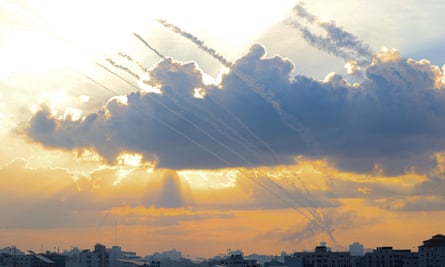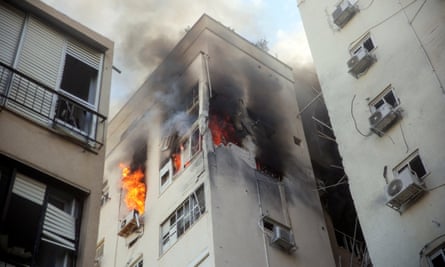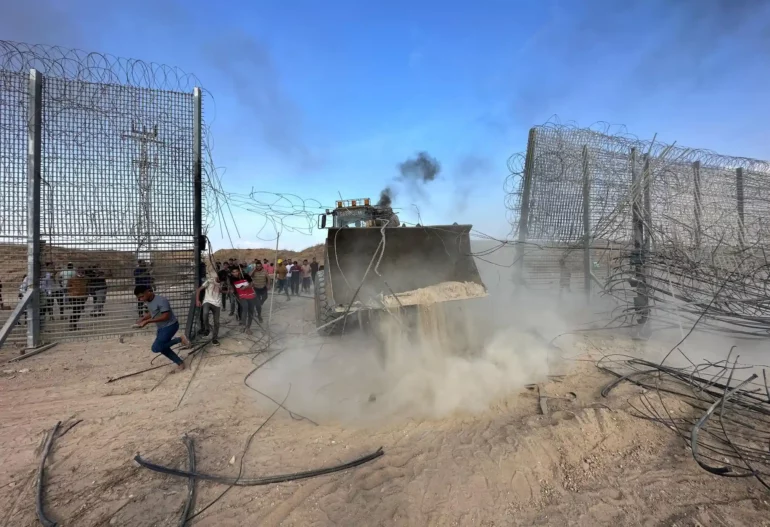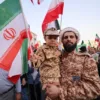Twenty-two Israelis confirmed dead so far and 545 injured, with death toll likely to rise, after aerial and ground attack
Israel and Hamas are once again at war after the Palestinian militant group launched a large aerial and ground operation from the blockaded Gaza Strip, its biggest attack in years.
Sirens sounded across Israel and as far north as the contested city of Jerusalem from about 7am on Saturday after volleys of what Hamas claimed were 5,000 rockets launched from the blockaded enclave. A ground infiltration by Hamas gunmen into Israeli towns and villages on the periphery – an unprecedented development in the 16 years since the Islamists took over the strip – is ongoing, with the Israel Defence Forces (IDF) saying that at one point, seven villages and towns were under Hamas control. The Israeli army put the number of projectiles at about 2,200.
In response to the attacks, which appear to have caught the Israeli security services by surprise, Israel has declared a state of war.
“Our enemy will pay a price the type of which it has never known,” Israel’s prime minister, Benjamin Netanyahu, said in a televised statement. “We are in a war and we will win it.”
Unconfirmed initial reports and graphic pictures and video appeared to show that gunmen had opened fire in the border town of Sderot, killing several Israeli civilians and soldiers. It has been confirmed that an elderly woman died in a rocket attack, and that another four people in Bedouin villages in Israel’s south were killed by rocket fire.
One hundred Israelis have been confirmed dead so far and 908 injured, with the death toll likely to rise. At least 198 Palestinians were reported killed in Gaza in retaliatory Israeli airstrikes beginning on Saturday afternoon, and five Hamas militants were reported killed inside Israel.

An unknown number of Israelis have been taken captive by fighters, with unverified social media footage showing elderly people and a young woman with her hands tied inside Gaza. The IDF later confirmed both civilian and military hostages had been taken to Gaza, but did not give details.

In a statement, Mohammed Deif, Hamas’s military commander in Gaza, announced the start of a new operation to free Jerusalem’s sensitive al-Aqsa mosque compound, which has had an increase in the number of Jewish visitors in the past few weeks owing to the Jewish high holidays. He said this was only the first stage of Hamas’s renewed efforts against Israel.
“We warned the enemy not to continue their aggression against the al-Aqsa mosque … The age of the enemy’s aggression without a response is over. I call on Palestinians everywhere in the West Bank and within the Green Line [Israeli territory] to launch an attack without restraint. Go to all the streets. I call on Muslims everywhere to launch an attack,” he said.

Islamic Jihad, another faction in Gaza, said in a statement on Telegram several hours later that they had joined the fighting. There are fears of a regional conflagration should the violence spread to the occupied West Bank, which is on partial lockdown, or to the northern front with the Lebanese militant group Hezbollah, or if intra-communal violence breaks out on the streets of Israel, as seen in 2021.
Both Hezbollah, and its backers in Iran, issued statements of support for Hamas’s operation.
The Israeli military said in a statement: “A number of terrorists have infiltrated into Israeli territory from the Gaza Strip,” adding that residents in the areas surrounding the strip had been told to stay in their homes.
“The IDF will defend Israeli civilians, and the Hamas terrorist organisation will pay a heavy price for its actions,” it said. Reservist forces have been mobilised.
Inside the strip on Saturday, civilians reported significant movement of armed factions, as people braced for a major escalation.
Mona Awda, a 31-year-old from Gaza City, said: “I was helping my children to go to school. All of a sudden explosions happened. My children were freaked out. I told them to stay at home and not go to school. We are surprised and worried about what’s next, wondering when and how long this will last.”
Saturday’s dramatic developments are the most serious flare-up in the volatile region since Israel and Hamas fought a 10-day battle in 2021, and so far appear to be on a more dangerous scale.

Shaike Shaked, 70, from the Israeli town of Netiv Hahasara, said: “We are locked in the security room and don’t know what is happening outside. We can hear explosions … We are nervous and alert. It is clear that this will lead to a war in Gaza.”
Since the Islamist group seized control of the strip – which is about 25 miles (41km) long and between 3.7 and 7.5 miles wide (6-12km) – in 2007, there have been four wars and several smaller conflagrations against the area’s rulers and its other active factions that have exacted a devastating toll on Gaza’s 2.3 million residents.
People in Gaza also have next to no freedom of movement. Healthcare, electricity, sanitation and other crucial infrastructure have all but collapsed since Israel and Egypt imposed the blockade after the Hamas takeover.
The violence follows the most deadly period in Jerusalem and the occupied West Bank in 20 years, and widespread fears of a new intifada, or Palestinian uprising.
Clashes between Palestinians and settlers or IDF forces were also reported throughout the West Bank and Jerusalem on Saturday.
Israel’s army relies heavily on reservists, thousands of whom had pledged to stop reporting for duty in protest against a judicial overhaul being pushed by Netanyahu’s far-right allies. On Saturday, however, political differences were put aside as reservists scrambled to army bases.


